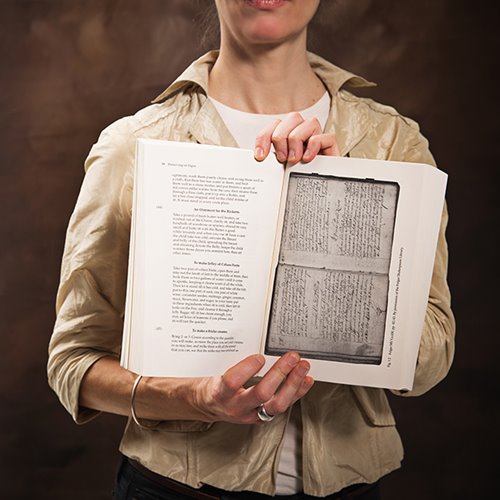Kitchen was a place of cooking, curing, reading and writing, says NAIT instructor
Kristine Kowalchuk was doing PhD research at the Folger Shakespeare Library in Washington, D.C. when she accidentally called up a manuscript from the storage vaults.
“I was just amazed to open it and see this handwritten collection of recipes from the time of Shakespeare,” says the NAIT instructor in the Bachelor of Technology in Technology Management program. “It immediately compelled me and I wrote a paper about it.”
That paper became her PhD thesis – an unconventional cookbook and social history of domestic life in 17th century England. The book, called Preserving on Paper, includes hundreds of recipes (or “receipts” as they were called at the time) for the food and medicines of the day.
 Kitchen culture recorded by women
Kitchen culture recorded by women
The book also provides a fascinating look at how women lived at the time, based on the contents of three receipt books: one from 1672 attributed to Constance Hall, one from 1675 attributed to Lettice Pudsey, and one from 1740 attributed to Mary Granville and her daughter, Anne Granville D’Ewes.
“Basically what we have here in these recipes is an oral culture in its first stages of being recorded,” says Kowalchuk. “The kitchen became not only a place of cooking and curing, but also a place of reading and writing and that was really a major step in terms of women’s literacy.” But it is important to note that women were already the experts and authorities in these areas, she adds.
The book includes familiar recipes for cakes, puddings and meat pies, albeit with much looser, intuitive directions than we use in today’s cookbooks. Measures like “a convenient quantity of butter,” and temperatures “as hot as you can” are common in the book.
Kowalchuk has maintained the original spellings and terminology, adding a glossary to explain some of the more perplexing ones like firkin (a small cask a quarter the size of a barrel) and glair (the white of an egg). The glossary includes many of the commonly used medicinal plants and herbs such as feverfew, devil’s-bit and pennyroyal.
Odd combinations
Some of the recipes might seem unappetizing to today’s palates, such as calves head pie or marrow pudding. Many include strange combinations of ingredients, like the egg dish that Kowalchuk made from the book, which included sugar, herbs and rose water.
“That just sounds so bizarre, but it actually tasted really lovely,” she says.
“There were so many people who came together to create these texts because that’s the way the culture was then. I see my own role now as a later contributor.”
She was also surprised by the diversity of herbs and wild plants that were used, particularly in medicinal remedies. The range of ailments the women aimed to cure is also fascinating – “a receipt for the dropsie,” “Mr. Bamber’s medicine for a horse that has the grypes,” “to take out the holes of the smallpox,” and “a water to cure pimples in the face” are just a few examples.
17th century dinner sold out
Recipes from Kowalchuk’s book, Preserving on Paper, were adapted by Michael Hassall (Cook '06), executive chef at Ernest’s, for a special, sold out dinner on Jan. 27, along with an introduction by Kowalchuk. Proceeds benefitted Food for Thought, a non-profit program providing food to hungry children in Edmonton schools.
Kowalchuk includes scans of some of the original pages of the manuscripts, to help the reader feel some of the same excitement and wonder she did at discovering the original pages. To read and understand those pages, she had to decipher the handwriting of the period, she says.
Each of the three receipt books contained more than 20 different peoples’ handwriting, a testament to how much the books were shared. Rather than individual authors, she sees them as contributors.
“There were so many people who came together to create these texts because that’s the way the culture was then. I see my own role now as a later contributor.”